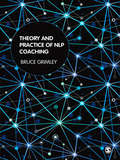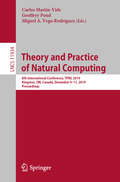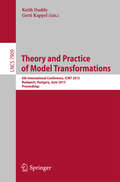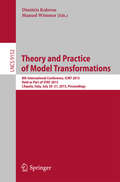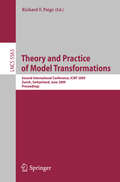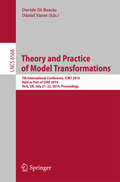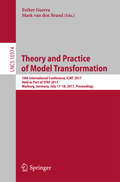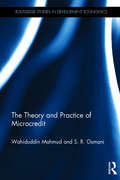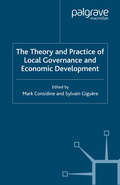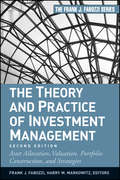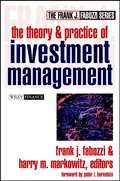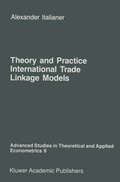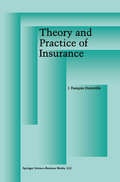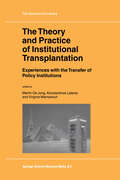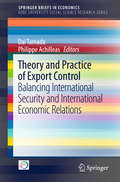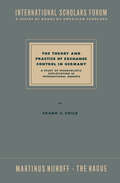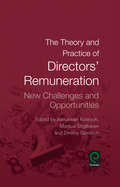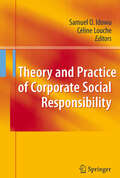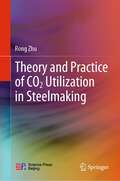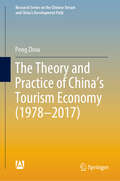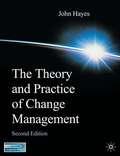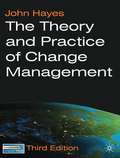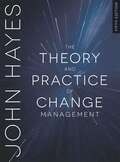- Table View
- List View
Theory and Practice of NLP Coaching: A Psychological Approach
by Bruce Grimley'Inspiring, stimulating, and immensely rich - Bruce takes NLP in Coaching to an entirely new dimension, building on the giants before him' - Katherine Tulpa, Global CE0, Association for Coaching 'I recommend this book whole heartedly to any coach who wishes to update their knowledge and understanding of NLP and coaching' - Prof. Dr. Karl Nielsen, IN President 'Immensely readable and well researched. No NLP practitioner wanting to develop the field further should be without it' - Dr Jane Mathison, formerly research officer in NLP, University of Surrey Are you struggling with the complexities of Neuro-Linguistic Programming (NLP)? You've come to the right place. This book demystifies NLP, providing a practical guide to understanding the psychological theories, principles and research that underpin the approach. Packed with practical hints and tips, case studies and exercises, the book introduces and explores: - What NLP coaching actually is - The general theories and principles that underpin the NLP approach - How theory translates into practice - The research evidence that says NLP coaching really works This is an essential companion for trainees, coaches, psychologists and professionals from all walks of life - indeed, anyone wanting to develop their knowledge and practical skills in this increasingly popular approach. Bruce Grimley is Managing Director of Achieving Lives Ltd, an Associate Fellow of the British Psychological Society and the UK President of the International Association of NLP Institutes and Coaching Institutes.
Theory and Practice of Natural Computing: 8th International Conference, TPNC 2019, Kingston, ON, Canada, December 9–11, 2019, Proceedings (Lecture Notes in Computer Science #11934)
by Carlos Martín-Vide Geoffrey Pond Miguel A. Vega-RodríguezThis book constitutes the refereed proceedings of the 8th International Conference on Theory and Practice of Natural Computing, TPNC 2019, held in Kingston, ON, Canada, in December 2019. The 15 full papers presented in this book, together with two invited talk, were carefully reviewed and selected from 38 submissions. The papers are organized in topical sections named: Applications of Natural Computing; Evolutionary Computation; Genetic Algorithms, Swarm Intelligence, and Heuristics; Quantum Computing and Information.
Theory and Practice of Model Transformations: 6th International Conference, ICMT 2013, Budapest, Hungary, June 18-19, 2013, Proceedings (Lecture Notes in Computer Science #7909)
by Keith Duddy Gerti KappelThis book constitutes the refereed proceedings of the 6th International Conference on Theory and Practice of Model Transformations, ICMT 2013, held in Budapest, Hungary, in June 2013. The 13 full papers and 5 tool and application demonstrations were carefully selected from 58 submissions. The papers are grouped in topical sections which focus on new programming models, tools and applications, evolution and synchronization, transformation engineering, and testing.
Theory and Practice of Model Transformations: 8th International Conference, ICMT 2015, Held as Part of STAF 2015, L'Aquila, Italy, July 20-21, 2015. Proceedings (Lecture Notes in Computer Science #9152)
by Dimitris Kolovos Manuel WimmerThis book constitutes the refereed proceedings of the 8th International Conference on Model Transformation, ICMT 2015, held in L'Aquila, Italy, in July 2015, as Part of STAF 2015, the federation of a number of the leading conferences on software technologies. The 16 revised papers were carefully selected from 34 submissions. The papers are organized in topical sections on change management; reuse and industrial applications; new paradigms for model transformation; transformation validation and verification; and foundations of model transformation.
Theory and Practice of Model Transformations: Second International Conference, ICMT 2009, Zürich, Switzerland, June 29-30, 2009, Proceedings (Lecture Notes in Computer Science #5563)
by Richard F. PaigeModels have become essential for supporting the development, analysis and e- lution of large-scale and complex IT systems. Models allow di?erent views, p- spectives and elements of a system to be captured rigorously and precisely, thus allowing automated tools to manipulate and manage the models. In a full-?edged model-driven engineering (MDE) process, the transformations developed and - pressed between models are also key. Model transformations allow the de?nition and implementation of the operations on models, and also provide a chain that enables the automated development of a system from its corresponding m- els. Model transformations are already an integral part of any model-driven approach, and there are a number of available model transformation languages, tools, and supporting environments; some of these approaches are now approa- ing maturity. Nevertheless, much work remains: the research community and industry need to better understand the foundations and implications of model transformations, such as the key concepts and operators supporting transfor- tion languages, their semantics, and their structuring mechanisms and properties (e. g. , modularity, composability and parametrization). The e?ect of using model transformations on organizations and development processes – particularly when applied to ultra-large scale systems, or in distributed enterprises – is still not clear. These issues, and others related to the speci?cation, design, implemen- tion, analysis and experimentation with model transformation, are the focus of these proceedings. The Second International Conference on Model Transformation (ICMT 2009) was held in late June 2009 in Zurich, Switzerland.
Theory and Practice of Model Transformations: 7th International Conference, ICMT 2014, Held as Part of STAF 2014, York, UK, July 21-22, 2014, Proceedings (Lecture Notes in Computer Science #8568)
by Davide Di Ruscio Dániel VarróThis book constitutes the refereed proceedings of the 7th International Conference on Model Transformation, ICMT 2014, held in York, UK, in July 2014. The 14 revised papers were carefully selected from 38 submissions. The papers have been organized in topical sections on model transformation testing, foundations of model synchronization, applications of model synchronization and tracing and reverse engineering of transformations.
Theory and Practice of Model Transformation: 10th International Conference, ICMT 2017, Held as Part of STAF 2017, Marburg, Germany, July 17-18, 2017, Proceedings (Lecture Notes in Computer Science #10374)
by Esther Guerra Mark van den BrandThis book constitutes the refereed proceedings of the 10th International Conference on Model Transformation, ICMT 2017, held as part of STAF 2017, in Marburg, Germany, in July 2017.The 9 full papers and 2 short papers were carefully reviewed and selected from 31 submissions. The papers are organized in the following topical sections: transformation paradigms, languages, algorithms and strategies; development of transformations; and applications and case studies.
The Theory and Practice of Microcredit (Routledge Studies in Development Economics)
by Wahiduddin Mahmud S. R. OsmaniThe remarkable speed at which microcredit has expanded around the world in the last three decades has piqued the curiosity of practitioners and theorists alike. By developing innovative ways of making credit available to the poor, the idea of microcredit has challenged many traditional assumptions about both poverty reduction strategies and financial markets. While this has encouraged new theorising about how microcredit works, the practice of microcredit has itself evolved, often in unpredictable ways, outpacing the development of theory. The Theory and Practice of Microcredit aims to remedy this imbalance, arguing that a proper understanding of the evolution of practice is essential both for developing theories that are relevant for the real world and for adopting policies that can better realize the full potential of microcredit. By drawing upon their first-hand knowledge of the nature of this evolution in Bangladesh, the birthplace of microcredit, the authors have pushed the frontiers of current knowledge through a rich blend of theoretical and empirical analysis. The book breaks new grounds on a wide range of topics including: the habit-forming nature of credit repayment; the institutional strength and community-based role of microfinance institutions; the relationships between microcredit and informal credit markets; the pattern of long-term participation in microcredit programmes and the variety of loan use; the scaling up of microenterprises beyond subsistence; the "missing middle" in the credit market; and the prospects of linking micro-entrepreneurship with economic development. The book will be of interest to researchers, development practitioners and university students of Development Economics, Rural Development, or Rural Finance, as well as to public intellectuals.
The Theory and Practice of Microcredit (Routledge Studies in Development Economics)
by Wahiduddin Mahmud S. R. OsmaniThe remarkable speed at which microcredit has expanded around the world in the last three decades has piqued the curiosity of practitioners and theorists alike. By developing innovative ways of making credit available to the poor, the idea of microcredit has challenged many traditional assumptions about both poverty reduction strategies and financial markets. While this has encouraged new theorising about how microcredit works, the practice of microcredit has itself evolved, often in unpredictable ways, outpacing the development of theory. The Theory and Practice of Microcredit aims to remedy this imbalance, arguing that a proper understanding of the evolution of practice is essential both for developing theories that are relevant for the real world and for adopting policies that can better realize the full potential of microcredit. By drawing upon their first-hand knowledge of the nature of this evolution in Bangladesh, the birthplace of microcredit, the authors have pushed the frontiers of current knowledge through a rich blend of theoretical and empirical analysis. The book breaks new grounds on a wide range of topics including: the habit-forming nature of credit repayment; the institutional strength and community-based role of microfinance institutions; the relationships between microcredit and informal credit markets; the pattern of long-term participation in microcredit programmes and the variety of loan use; the scaling up of microenterprises beyond subsistence; the "missing middle" in the credit market; and the prospects of linking micro-entrepreneurship with economic development. The book will be of interest to researchers, development practitioners and university students of Development Economics, Rural Development, or Rural Finance, as well as to public intellectuals.
The Theory and Practice of Local Governance and Economic Development
by M. Considine S. GiguereThis book provides a comparative study of the use of partnerships and new forms of governance to achieve policy goals that promote economic and social development. In addition to a consideration of the theoretical challenges posed by these institutional developments, the book reviews recent experiences in Asia-Pacific, Europe and North America.
The Theory and Practice of Investment Management: Asset Allocation, Valuation, Portfolio Construction, and Strategies (Frank J. Fabozzi Ser. #94)
by Frank J. Fabozzi Harry M. MarkowitzAn updated guide to the theory and practice of investment management Many books focus on the theory of investment management and leave the details of the implementation of the theory up to you. This book illustrates how theory is applied in practice while stressing the importance of the portfolio construction process. The Second Edition of The Theory and Practice of Investment Management is the ultimate guide to understanding the various aspects of investment management and investment vehicles. Tying together theoretical advances in investment management with actual practical applications, this book gives you a unique opportunity to use proven investment management techniques to protect and grow a portfolio under many different circumstances. Contains new material on the latest tools and strategies for both equity and fixed income portfolio management Includes key take-aways as well as study questions at the conclusion of each chapter A timely updated guide to an important topic in today's investment world This comprehensive investment management resource combines real-world financial knowledge with investment management theory to provide you with the practical guidance needed to succeed within the investment management arena.
The Theory and Practice of Investment Management: Asset Allocation, Valuation, Portfolio Construction, and Strategies
by Frank J. Fabozzi Harry M. MarkowitzAn updated guide to the theory and practice of investment management Many books focus on the theory of investment management and leave the details of the implementation of the theory up to you. This book illustrates how theory is applied in practice while stressing the importance of the portfolio construction process. The Second Edition of The Theory and Practice of Investment Management is the ultimate guide to understanding the various aspects of investment management and investment vehicles. Tying together theoretical advances in investment management with actual practical applications, this book gives you a unique opportunity to use proven investment management techniques to protect and grow a portfolio under many different circumstances. Contains new material on the latest tools and strategies for both equity and fixed income portfolio management Includes key take-aways as well as study questions at the conclusion of each chapter A timely updated guide to an important topic in today's investment world This comprehensive investment management resource combines real-world financial knowledge with investment management theory to provide you with the practical guidance needed to succeed within the investment management arena.
The Theory and Practice of Investment Management (Frank J. Fabozzi Series #118)
by Frank J. Fabozzi Harry M. MarkowitzExpert advice that applies the theory and practice of investment management to today's financial environment The changing nature and rapid growth of the investment management industry, along with new theoretical developments in the field of finance, have led to a need for higher quality investment management practices and better qualified professionals. The Theory and Practice of Investment Management recognizes these needs and addresses them with sharp, innovative insights from some of the most respected experts in the field of investment management. The Theory and Practice of Investment Management discusses and describes the full scope of investment products and strategies available in today's market. Led by financial experts Frank Fabozzi and Harry Markowitz, the contributors to this book are active, successful practitioners with hands-on expertise. By combining real-world financial knowledge with investment management theory, this book provides a complete analysis of all pertinent investment products-including hedge funds and private equity-and explores a wide range of investment strategies. Tying together theoretical advances in investment management with actual applications, this book gives readers an opportunity to use proven investment management techniques to protect and grow a portfolio under many different circumstances.
Theory and Practice of International Trade Linkage Models (Advanced Studies in Theoretical and Applied Econometrics #9)
by A. ItalianerThis book was mainly written while I stayed at the Catholic University of Louvain. Professor Anton P. Barten was the one who did not only give me a warm welcome in Louvain, but also supported my research with most valuable comments and constructive criticisms. In addition I benefitted from dis cussions with Erik Schokkaert, Denis de Crombrugghe and Jo Baras on various subjects, such as the small-sample correction of Chapter 9. The arduous task of transferring my neat handwriting into a readable typescript was excellently taken care of by Brs. E. Crabbe and notably Brs. F. Duij sens, even after working hours. Mrs. A. Molders prevented me of making serious abuse of the English language. My admiration for Carien, finally, is an exponential function of the patience and enthusiasm with which she sup ported my research. Chapter I is a general introduction to the subject of linkage models, and it contains few mathematical elaborations. Chapters 2 to 4 use more, but elementary, mathematics, and treat several aspects related to the deriva tion, interpretation and estimation of linkage models. Chapter 2 deals vii tll the theory of import allocation models, Chapter J treats the problem of defining and interpreting elasticities of substitution, while Chapter 4 is concerned with the econometric problems related to the estimation of mul tivariate models with linear restrictions, such as import allocation models.
Theory and Practice of Insurance
by J. François OutrevilleInsurance is a concept, a technique, and an economic institution. It is a major tool of risk management, and plays an important role in the economic, social, and political life of all countries. Economic growth throughout the world has even expanded the role of insurance. Theory and Practice of Insurance aims to describe the significance of insurance institutions, the reasons they exist and how they function. The author emphasizes fundamental principles in risk and insurance, using an international frame of reference. This volume begins with an introduction to the concept of risk, then proceeds to cover insurance and its relationship to the economy; the principles of risk management and insurance; and the characteristics and performance of insurance companies.
The Theory and Practice of Institutional Transplantation: Experiences with the Transfer of Policy Institutions (GeoJournal Library #74)
by VirginieMamadouh KonstantinosLalenis MartinJongInevitably, at a panel discussion not too long ago comparing planning cultures the discussion turned on the issue of globalisation. As a member of the panel, this author asked those in the audience who lived and/or worked in a country different from their country of origin to raise their hands. About half of the audience of well over one hundred academic teachers and researchers from all comers of the world, the present author included did so. Next he asked who had a spouse or partner from a country different from their country of origin to also raise their hands. About half of the audience, the present author included, raised their hands. This is the soft side of globalisation. The soft side of globalisation is important. Exchanges, personal mobility, international romances, multi-culturalism and multi-lingualism (inevitably meaning non-native speakers struggling to keep up with native English speakers) are part of the academic scene, so much so that we can hardly imagine it to be otherwise. These are not entirely new phenomena, but they have become ever more prominent, relying on an ever more elaborate institutional infrastructure of exchange programmes, international journals, associations and the global conference industry. It was at the AESOP (Association of European Schools of Planning) congress at Bmo in the Czech Republic in July 2000 that the plan for this book was hatched.
Theory and Practice of Export Control: Balancing International Security and International Economic Relations (SpringerBriefs in Economics)
by Dai Tamada Philippe AchilleasThis is the first book to focus on the theoretical and practical issues of export control. It combines the points of view of Japanese and French academics and practitioners, including personnel at several governmental institutions and private companies. Presenting the results of a collaboration between Japanese and French academics, it contributes to the development of a new debate on export control. Although export control has been discussed within the framework of international law in terms of peace and security, its scope has now been expanded to international economic law (i.e., WTO law and international investment law). This means that in order to discuss export control appropriately, the two areas of law have to be combined. At the same time, this topic is not only academic and theoretical but touches upon very real and practical aspects of trade, export, and foreign investment. When we tighten embargos and economic sanctions for anti-terrorism or anti-nuclearization purposes, we encounter more and more cases of conflict between security and the liberalization of economic relations in the world. For this reason, a wide range of collaborative work is needed in this area. This timely book addresses various aspects of the current export control debate.
The Theory and Practice of Exchange Control in Germany: A Study of Monopolistic Exploitation in International Markets (International Scholars Forum #10)
by NA ChildThe Classical economist of the 19th century, with his faith in the ultimate efficiency and equity of free, impersonal markets, would certainly be amazed and dismayed by the developments in foreign exchange markets during the last thirty-five years. With the exception of the United States no important trading nation in the world of today maintains a freely convertible currency. On the contrary, each nation maintains a more or less comprehensive system of controls over the receipts and payments which can be effected in international markets. Recent efforts to reduce the extent and rigor of exchange regu lation, notably in Western Europe, have yielded modest results; it seems unlikely, however, that foreign exchange transactions will ever again be completely free of controL Foreign exchange control, with a greater or lesser degree of bilateralism, is a product born largely of necessity. Two world wars and a major world-wide depression so distorted the pattern of world trade and investment that free markets were simply unable to achieve their "normal" automatic adjustment. Ex change control, on the other hand, has demonstrated its efficiency as a means of maintaining a semblance of order in disorganized international markets. Unfortunately, however, exchange con trol also has great possibilities for further distortion of the pat tern of world trade, for discrimination, and for economic ex ploitation - for economic effects generally considered undesirable.
The Theory and Practice of Directors' Remuneration: New Challenges and Opportunities
by Alexander Kostyuk Markus Stiglbauer Dmitriy GovorunThe recent financial crisis has led to a loss of trust in corporate governance and in particular on remuneration practices and the propensity for these to create excessive risk-taking - particularly in the financial sector. The main objective of this book is to outline recent practical and theoretical issues and examine emerging new approaches towards directors' remuneration in the post-crisis period. Written by an established network of international experts, the book provides new data in both cross-sector and cross-country analyses and therefore provides a unique opportunity to compare results and institutional practices across sectors and nations. The book argues for a correct balance between risk and reward and for Directors' compensation to be equitable to all parties and stakeholders. By examining the current theories, practices and regulations and explaining them in detail it provides a state of the art snapshot of one of the key corporate governance issues of our time.It will be essential reading for graduate students, researchers, lecturers and practitioners in corporate governance and auditing as well as all students in finance, accounting, management and law.
Theory and Practice of Corporate Social Responsibility
by Samuel O. Idowu and Celine LoucheModern businesses and organizations understand that corporate social responsibility (CSR) has become an important factor for sustainable success. At the same time CSR has established itself as a widely accepted element of courses in managerial training and education. This book, designed to support CSR teaching, collects 14 essays that clearly illustrate and explain the benefits and challenges of socially responsible corporate policies.Aligning theory and practice, the book focuses on four central themes: management, environment and sustainability, corporate social responsibility, and accounting and financial reporting. Business students and experienced managers alike will find this book a valuable resource that helps them to discover the strong forces that link successful management with corporate social responsibility.
Theory and Practice of CO2 Utilization in Steelmaking
by Rong ZhuThis book analyzes the mechanism of the application of CO2 in steelmaking, by looking at the thermodynamics and kinetics of the reactions of CO2 with the elements present in molten steel. This book is the first academic monograph either at home or abroad on the application of CO2 in the steelmaking field. The thermodynamic conditions of the reactions of CO2 with silicon, manganese, phosphorus, chromium, nickel, vanadium, and other elements were calculated and analyzed using the FactSage thermodynamic software, and the selective oxidation law of the above multiple elements by CO2 was also analyzed. In terms of kinetics, the interfacial reaction mechanism of CO2 was analyzed via gas isotope exchange technology, and the O2 transfer process and transfer rate between the CO2, slag, and steel were studied. In terms of materials and energy balance, how to use the high-temperature characteristics of CO2 to control the temperature of the molten pool, improve the reaction conditions of molten iron, reduce the evaporation of molten iron, and reduce the amount of steelmaking dust were introduced. Based on the experimental data, theoretical models of unit operation for the application of CO2 in steelmaking were established, including decarburization, denitrification, dephosphorization, decarburization and chromium retention, vanadium extraction, and carbon preservation, and these theoretical models were applied to the steelmaking production process, which is an important step in going from theory to practice. The above research work has opened up a new solution for energy saving and liquid steel cleaning in the iron and steel production process and represents progress in steelmaking technology. This book is used as a reference book for managers, engineering and technical personnel, and related professional teachers and students of Iron & Steel enterprises, government departments, consulting services and evaluation agencies, colleges, and secondary professional schools.
The Theory and Practice of China's Tourism Economy (Research Series on the Chinese Dream and China’s Development Path)
by Peng ZhouThis book is devoted to the analysis of the three main tasks of China’s tourism development: Firstly, the theory of tourism development since the initiation of reform and opening-up. Secondly, the practice and problems in infrastructure building. Thirdly, the mold and policy used in the course of development. The book pursues three major objectives: firstly, to portray the stage of development; secondly, to analyze the specific experience in China’s case; thirdly, to review theory and try to put forward advice on investment and management.
The Theory And Practice Of Change Management (Second Edition) (PDF)
by John HayesThis is a core textbook for all courses in change management. It examines all of the key theories on organizational change and applies them to organizational settings to demonstrate how strategies can be devised and employed to help manage organizational change and the issues it precipitates. Taking quite a practical approach, students are helped to apply theory to real-world scenarios through the use of experiential learning and cases. Companion Website: http://www. palgrave. com/business/hayes2/index. html
The Theory and Practice of Change Management (3rd Edition) (PDF)
by John HayesA core textbook for all modules in Change Management, John Hayes examines and applies all of the key theories on change to organisational settings. Diagnostic tools and immersive learning exercises enable students to identify change and experience various outcomes based on real-world scenarios. The unique experiential learning exercises allow students to reflect on their own experiences of change. Hayes strikes a balance between theory and practice by examining the key theories on change and applying those theories to organisational settings to demonstrate how organisations can develop practical tools to help implement change. Key Features- Blend of theory and practice- Breadth of coverage- Experiential learning exercises - allow students to play the role of a consultant and diagnose a need for change- Case studies- Diagnostic tools to help students grasp the practical techniques - Accessible - especially for those with no prior knowledge of change management theory- A comprehensive companion website NEW for the 3rd Edition- 2 colour design - 5 new chapters covering the latest developments - New thinking assignments - 12 new cases from a range of countries including Denmark, The Netherlands, India, China, USA, Germany and from a range of sectors (NGOs, not-for-profit, large and small companies, multi-national organisations, public and private sector)- New chapter on sustainability addresses how to make change 'stick' and how to 'spread' good practice through the organisation- Increased depth- Improved signposting and cross-referencing helps link the material together making it easier for students to see how everything fits together Companion Website: http: //www. palgrave. com/business/hayes3/
The Theory and Practice of Change Management: Second Edition
by John HayesJohn Hayes’ bestselling textbook combines a scholarly discussion of change management with a host of practical tools and techniques. It provides future managers with all the skills they need to diagnose the need for change and to ensure its successful implementation. The book’s unique underpinning framework views change as a purposeful and constructed sequence of events, rather than something chaotic and unmanageable. Its hands-on approach includes a number of ‘Change Tools’ that students can apply to various scenarios, an array of case studies and examples based on real-life organisations worldwide, and video interviews with experienced change practitioners, who share their insights on key topics. The book will be essential reading for final-year business undergraduates, as well as MBA and postgraduate students who are taking modules in change management or organisational change. It is also ideal for change practitioners and consultants.
